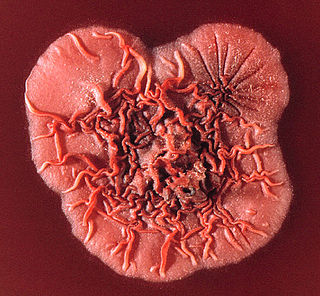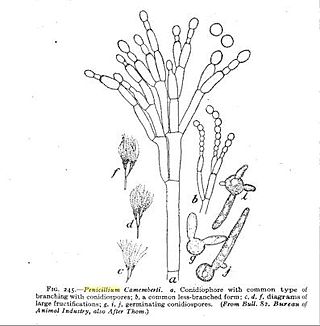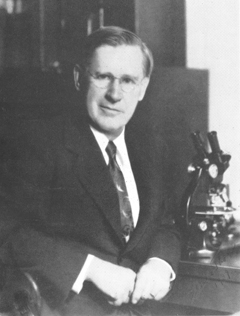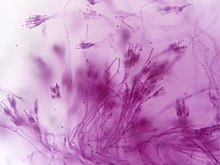
Ascomycota is a phylum of the kingdom Fungi that, together with the Basidiomycota, forms the subkingdom Dikarya. Its members are commonly known as the sac fungi or ascomycetes. It is the largest phylum of Fungi, with over 64,000 species. The defining feature of this fungal group is the "ascus", a microscopic sexual structure in which nonmotile spores, called ascospores, are formed. However, some species of Ascomycota are asexual and thus do not form asci or ascospores. Familiar examples of sac fungi include morels, truffles, brewers' and bakers' yeast, dead man's fingers, and cup fungi. The fungal symbionts in the majority of lichens such as Cladonia belong to the Ascomycota.

A mold or mould is one of the structures that certain fungi can form. The dust-like, colored appearance of molds is due to the formation of spores containing fungal secondary metabolites. The spores are the dispersal units of the fungi. Not all fungi form molds. Some fungi form mushrooms; others grow as single cells and are called microfungi.

Talaromyces marneffei, formerly called Penicillium marneffei, was identified in 1956. The organism is endemic to southeast Asia where it is an important cause of opportunistic infections in those with HIV/AIDS-related immunodeficiency. Incidence of T. marneffei infections has increased due to a rise in HIV infection rates in the region.

Aspergillus is a genus consisting of several hundred mould species found in various climates worldwide.

Penicillium roqueforti is a common saprotrophic fungus in the genus Penicillium. Widespread in nature, it can be isolated from soil, decaying organic matter, and plants.

Penicillium camemberti is a species of fungus in the genus Penicillium. It is used in the production of Camembert, Brie, Langres, Coulommiers, and Cambozola cheeses, on which colonies of P. camemberti form a hard, white crust. It is responsible for giving these cheeses their distinctive flavors. An allergy to the antibiotic penicillin does not necessarily imply an allergy to cheeses made using P. camemberti.

Penicillium expansum is a psychrophilic blue mold that is common throughout the world in soil. It causes Blue Mold of apples, one of the most prevalent and economically damaging post-harvest diseases of apples.
The parasexual cycle, a process restricted to fungi and single-celled organisms, is a nonsexual mechanism of parasexuality for transferring genetic material without meiosis or the development of sexual structures. It was first described by Italian geneticist Guido Pontecorvo in 1956 during studies on Aspergillus nidulans. A parasexual cycle is initiated by the fusion of hyphae (anastomosis) during which nuclei and other cytoplasmic components occupy the same cell. Fusion of the unlike nuclei in the cell of the heterokaryon results in formation of a diploid nucleus (karyogamy), which is believed to be unstable and can produce segregants by recombination involving mitotic crossing-over and haploidization. Mitotic crossing-over can lead to the exchange of genes on chromosomes; while haploidization probably involves mitotic nondisjunctions which randomly reassort the chromosomes and result in the production of aneuploid and haploid cells. Like a sexual cycle, parasexuality gives the species the opportunity to recombine the genome and produce new genotypes in their offspring. Unlike a sexual cycle, the process lacks coordination and is exclusively mitotic.

A fungus is any member of the group of eukaryotic organisms that includes microorganisms such as yeasts and molds, as well as the more familiar mushrooms. These organisms are classified as one of the traditional eukaryotic kingdoms, along with Animalia, Plantae and either Protista or Protozoa and Chromista.

Penicillium chrysogenum is a species of fungus in the genus Penicillium. It is common in temperate and subtropical regions and can be found on salted food products, but it is mostly found in indoor environments, especially in damp or water-damaged buildings. It has been recognised as a species complex that includes P. notatum, P. meleagrinum, and P. cyaneofulvum. Molecular phylogeny has established that Alexander Fleming's first discovered penicillin producing strain is of a distinct species, P. rubens, and not of P. notatum. It has rarely been reported as a cause of human disease. It is the source of several β-lactam antibiotics, most significantly penicillin. Other secondary metabolites of P. chrysogenum include roquefortine C, meleagrin, chrysogine, 6-MSA YWA1/melanin, andrastatin A, fungisporin, secalonic acids, sorbicillin, and PR-toxin.

The fungi imperfecti or imperfect fungi are fungi which do not fit into the commonly established taxonomic classifications of fungi that are based on biological species concepts or morphological characteristics of sexual structures because their sexual form of reproduction has never been observed. They are known as imperfect fungi because only their asexual and vegetative phases are known. They have asexual form of reproduction, meaning that these fungi produce their spores asexually, in the process called sporogenesis.

Charles Thom was an American microbiologist and mycologist. Born and raised in Illinois, he received his PhD from the University of Missouri, the first such degree awarded by that institution. He studied the microbiology of dairy products and soil fungi, and in particular researched the genera Aspergillus and Penicillium. His work influenced the establishment of standards for food handling and processing in the USA. He pioneered the use of culture media to grow microorganisms, and, with food chemist James N. Currie, developed a process to mass-produce citric acid using Aspergillus. Thom played an important role in the development of penicillin in World War II.

Penicillium rubens is a species of fungus in the genus Penicillium and was the first species known to produce the antibiotic penicillin. It was first described by Philibert Melchior Joseph Ehi Biourge in 1923. For the discovery of penicillin from this species Alexander Fleming shared the Nobel Prize in Physiology or Medicine in 1945. The original penicillin-producing type has been variously identified as Penicillium rubrum, P. notatum, and P. chrysogenum among others, but genomic comparison and phylogenetic analysis in 2011 resolved that it is P. rubens. It is the best source of penicillins and produces benzylpenicillin (G), phenoxymethylpenicillin (V) and octanoylpenicillin (K). It also produces other important bioactive compounds such as andrastin, chrysogine, fungisporin, roquefortine, and sorbicillins.
Medicinal fungi are fungi that contain metabolites or can be induced to produce metabolites through biotechnology to develop prescription drugs. Compounds successfully developed into drugs or under research include antibiotics, anti-cancer drugs, cholesterol and ergosterol synthesis inhibitors, psychotropic drugs, immunosuppressants and fungicides.
Penicillium carneum is a fungus species of the genus of Penicillium.Penicillium roqueforti var. carneum was reclassified to Penicillium carneum.P. carneum was isolated from spoiled meat products, silage, rye bread, water, beer, cheese, mouldy barkers yeast and cork. P. carneum produces patulin, penicillic acid, penitrem A, mycophenolic acid roquefortines.
Penicillium psychrosexualis is a filamentous fungus in the genus Penicillium. Described as new to science in 2010, the species was found growing on refrigerated moldy apples in the Netherlands. It is closely related to the blue cheese fungus P. roqueforti.

Penicillium digitatum is a mesophilic fungus found in the soil of citrus-producing areas. It is a major source of post-harvest decay in fruits and is responsible for the widespread post-harvest disease in Citrus fruit known as green rot or green mould. In nature, this necrotrophic wound pathogen grows in filaments and reproduces asexually through the production of conidiophores and conidia. However, P. digitatum can also be cultivated in the laboratory setting. Alongside its pathogenic life cycle, P. digitatum is also involved in other human, animal and plant interactions and is currently being used in the production of immunologically based mycological detection assays for the food industry.

Human interactions with fungi include both beneficial uses, whether practical or symbolic, and harmful interactions such as when fungi damage crops, timber, food, or are pathogenic to animals.
Penicillium commune is an indoor fungus belonging to the genus Penicillium. It is known as one of the most common fungi spoilage moulds on cheese. It also grows on and spoils other foods such as meat products and fat-containing products like nuts and margarine. Cyclopiazonic acid and regulovasine A and B are the most important mycotoxins produced by P. commune. The fungus is the only known species to be able to produce both penitrem A and roquefortine. Although this species does not produce penicillin, it has shown to have anti-pathogenic activity. There are no known plant, animal or human diseases caused by P. commune.
Aspergillus giganteus is a species of fungus in the genus Aspergillus that grows as a mold. It was first described in 1901 by Wehmer, and is one of six Aspergillus species from the Clavati section of the subgenus Fumigati. Its closest taxonomic relatives are Aspergillus rhizopodus and Aspergillus longivescia.



















